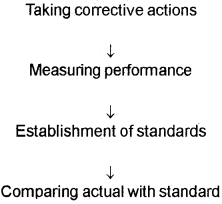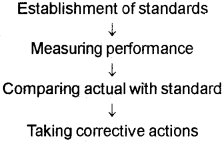Kerala Plus Two Business Studies Notes Chapter 8 Controlling
Plus Two Business Studies Controlling One Mark Questions and Answers
Question 1.
Which function of management consists of the following elements?
- Determination of standards
- Measuring performance
- Comparing performance with standards
- Taking corrective actions
Answer:
Controlling
Question 2.
The first step in the control process which a manager has to do is ………………………
Answer:
Setting standards
Question 3.
If managers try to control everything, they may end up controlling nothing. Identify the relevant management principle underlying this statement.
Answer:
Management by exception (MBE)
Question 4.
Identify the principle which indicates that only significant deviations from standards require the attention of management.
Answer:
Management by Exception (MBE)
Question 5.
An efficient control system helps to
(a) Accomplish organisational objectives
(b) Boost employee morale
(c) Judge accuracy of standards
(d) All of the above
Answer:
(d) All of the above
Question 6.
Pick out one statement which is not limitation of controlling.
(a) Standards cannot be fixed properly.
(b) Controlling has little control on external factors.
(c) It is costly and time-consuming process.
(d) Controlling is applicable at all levels of management.
Answer:
(d) Controlling is applicable at all levels of management.
Question 7.
Choose the right statement.
(a) Planning – Staffing are the two sides of the same coin.
(b) Planning – Controlling are the two sides of the same coin.
(c) Organising – Staffing are the two sides of the same coin.
(d) Directing-Planning are the two sides of the same coin.
Answer:
(b) Planning – Controlling are the two sides of the same coin.
Question 8.
Write two examples for modern controlling techniques.
Answer:
- Return on Investment method
- PERT & CPM
Question 9.
Choose the right tool for controlling.
(a) Critical Path Method (CPM)
(b) Common Policy Method (CPM)
(c) Production Evaluation and Review Technique (PERT)
(d) Personality Evaluation and Rare Technique (PERT)
Answer:
(a) Critical Path Method (CPM)
Question 10.
Return on Investment = ………………
Answer:
Net Income Total Investment
Question 11.
Comparing the values in a financial statement is called ……………..
(a) Return on Investment
(b) Ratio analysis
(c) Responsibility Accounting
(d) PERT & CPM
Answer:
(b) Ratio Analysis
Question 12.
Entrusting the responsibility of expenses to different departments is called …………………
Answer:
Responsibility accounting
Question 13.
Modem controlling techniques used to both planning and controlling are ……………………
Answer:
PERT & CPM
Question 14.
What is management audit?
(a) Evaluate the efficiency of management.
(b) Analyse the financial statement by using ratios.
(c) Charge the expenses to departments and evaluate the responsibilities.
(d) No profit No loss.
Answer:
(a) Evaluate the efficiency of management.
Question 15.
Comparing Investment & Profit is ………………
Answer:
Return on Investment
Question 16.
Traditional method of controlling which helps to motivate employees is …………………..
Answer:
Personal observation
Question 17.
……………… is a network technique useful in planning and controlling.
Answer:
Critical Path Method (CPM)
Question 18.
B.E.P. =
Answer:
Break Even Point = Fixed cost Selling Price per Unit – Variable Cost per Unit
Question 19.
…………………. is a technique of managerial control in which standards are expressed in terms of money.
Answer:
Budgetary Control
Question 20.
………………. is a computer based managerial control technique.
Answer:
Management Information System (MIS)
Plus Two Business Studies Controlling Two Mark Questions and Answers
Question 1.
What is the significance of standard?
Answer:
Helpful in analysing deviation. It is compulsary to fix a standard in order to compare the actual performance.
Question 2.
What is deviation in controlling?
Answer:
It is the difference between actual performance and standard performance.
Question 3.
Rearrange the following in a correct sequence of steps in controlling.

Answer:

Question 4.
In the controlling process only these deviations from standard which seem exceptionally are brought to the attention of top management. Identify the relevant principle behind this.
Answer:
Management by exception / Control by exception.
Plus Two Business Studies Controlling Three Mark Questions and Answers
Question 1.
What is meant by budgetary control?
Answer:
Budgetary Control:
Budgetary control is a technique of managerial control in which all operations are planned in advance in the form of budgets and actual results are compared with budgetary standards.
Plus Two Business Studies Controlling Four Mark Questions and Answers
Question 2.
“They are the two blades of a scissor; one cannot work without the other”.
- Identify the management functions referred to this context.
- Explain the nature of relationships between these managerial functions.
Answer:
1. I agree with this statement.
2. Relationship between Planning and Controlling:
- Planning and control are interdependent and inseparable functions of management.
- Planning is a prerequisite for controlling.
- Planning initiates the process of management and controlling complete the process.
- Planning is prescriptive where as controlling is evaluative.
- Planning and controlling are both backward looking as well as forward looking functions.
- Planning based on facts makes controlling easier and effective.
Question 3.
Planning and control are interdependent and inseparable functions of management.
- Do you agree with this statement?
- Explain.
Answer:
1. I agree with this statement.
2. Relationship between Planning and Controlling:
- Planning and control are interdependent and inseparable functions of management.
- Planning is a prerequisite for controlling.
- Planning initiates the process of management and controlling complete the process.
- Planning is prescriptive where as controlling is evaluative.
- Planning and controlling are both backward looking as well as forward looking functions.
- Planning based on facts makes controlling easier and effective.
Question 4.
‘Planning is useless without control and control is aimless without plans.’
- Do you agree?
- Explain.
Answer:
1. I agree with this statement.
2. Relationship between Planning and Controlling:
- Planning and control are interdependent and inseparable functions of management.
- Planning is a prerequisite for controlling.
- Planning initiates the process of management and controlling complete the process.
- Planning is prescriptive where as controlling is evaluative.
- Planning and controlling are both backward looking as well as forward looking functions.
- Planning based on facts makes controlling easier and effective.
Plus Two Business Studies Controlling Five Mark Questions and Answers
Question 1.
Distinguish between Traditional & Modem Controlling Techniques.
- Return on Investment
- Ratio Analysis
- Budgetery Control
- Management Audit
- Statistical Data
- Responsibility Accounting
- Break Even Analysis
- PERT & CPM
- Personal Observation
Answer:
| Traditional Controlling Techniques | Modern Controlling Techniques |
| 1) Personal Observation | 1) Return on Investment |
| 2) Statistical Data | 2) Ratio Analysis |
| 3) Break Even Analysis | 3) Responsibility Accounting |
| 4) Budgetary Control | 4) Management Audit |
| 5) PERT & CPM |
Question 2.
Explain the limitations of Controlling.
Answer:
Limitations of Controlling:
1. Difficulty in setting quantitative standards:
Control system loses some of its effectiveness when standards cannot be defined in quantitative terms.
2. Little control on external factors:
Generally an enterprise cannot control external factors such as government policies, technological changes, competition, etc.
3. Resistance from employees:
Control is often resisted by employees. They see it as a restriction on their freedom.
4. Costly affair:
Control is a costly affair as it involves a lot of expenditure, time and effort.
Question 3.
List down the importance of Controlling.
Answer:
Importance of Controlling:
1. Accomplishing organisational goals:
The controlling function measures progress towards the organisational goals and brings to light the deviations, if any, and indicates corrective action.
2. Judging accuracy of standards:
A good control system enables management to verify whether the standards set are accurate.
3. Making efficient use of resources:
By exercising control, a manager seeks to reduce wastage of resources.
4. Improving employee motivation:
A good control system motivates the employees and helps them to give better performance.
5. Ensuring order and discipline:
Controlling creates an atmosphere of order and discipline in the organisation.
6. Facilitating co-ordination:
An efficient system of control helps to co-ordinate all the activities in the organisation.
Question 4.
Explain the different Techniques of Managerial Control.
Answer:
Techniques of Managerial Control:
1. Traditional Techniques:
a. Personal Observation:
It creates psychological pressure on the employees to perform well as they are aware that they are being observed personally on their job.
b. Statistical Reports:
Statistical analysis in the form of averages, percentages, ratios, correlation, etc. present useful information to the managers regarding performance of the organisation.
c. Break Even Analysis:
Break even analysis is a technique used by managers to study the relationship between costs, volume and profits. The sales volume at which there is no profit, no loss is known as break even point. It helps in estimating profits at different levels of activities.
B.E.P = Fs−v
F = Fixed cost
S = Selling price per unit
V = Variable cost per unit
d. Budgetary Control:
Budgetary control is a technique of managerial control in which all operations are planned in advance in the form of budgets and actual results are compared with budgetary standards.
2. Modem Techniques:
a. Return on Investment:
Return on Investment (ROI) can be used to measure overall performance of an organisation. It helps to know the invested capital has been used effectively for generating reasonable amount of return.
Return on investment = Net Income Total Investment
b. Ratio Analysis:
Ratio Analysis refers to analysis of financial statements through computation of ratios.
c. Responsibility Accounting:
Responsibility accounting is a system of accounting in which different sections, divisions, and departments of an organisation are set up as ‘Responsibility Centres’. The head of the centre is responsible for achieving the target set for his centre. E.g. Cost centre, Revenue centre, Profit centre, Investment centre, etc.
d. Management Audit:
Management audit may be defined as evaluation of the functioning, performance, and effectiveness of management of an organisation.
e. PERT and CPM:
PERT (Programme Evaluation and Review Technique) and CPM (Critical Path Method) are important network techniques useful in planning and controlling.
Plus Two Business Studies Controlling Eight Mark Questions and Answers
Question 1.
Controlling is a systematic function of management. Explain.
Answer:
Controlling Process:
Controlling is a systematic process involving the following steps.
- Setting performance standards
- Measurement of actual performance
- Comparison of actual performance with standards
- Analysing deviations
- Taking corrective action
1. Setting Performance Standards:
Standards are the criteria against which actual performance would be measured. Standards can be set in both quantitative as well as qualitative terms.
2. Measurement of Actual Performance:
After establishing standards, the next step is measurement of actual performance. Performance should be measured in an objective and reliable manner.
3. Comparing Actual Performance with Standards:
This step involves comparison of actual performance with the standard. Such comparison will reveal the deviation between actual and desired results.
4. Analysing Deviations:
The deviations from the standards are assessed and analysed to identify the causes of deviations.
5. Taking Corrective Action:
The final step in the controlling process is taking corrective action. No corrective action is required when the deviations are within acceptable limits.
